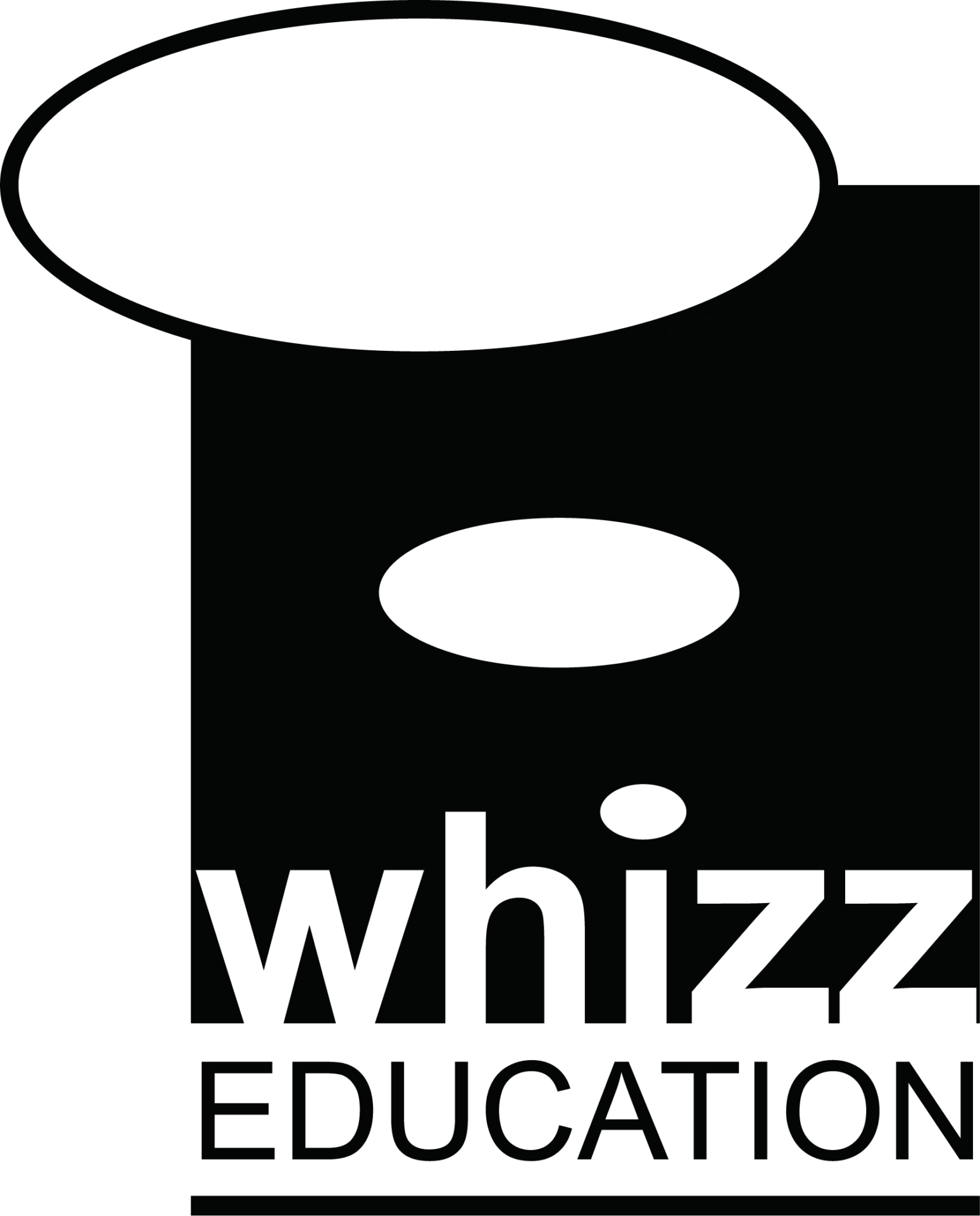Introduction
The recent joint publication by the UNESCO Institute for Statistics and the Global Education Monitoring Report for the 2019 High-level Political Forum on Sustainable Development (“Are Countries on Track to Achieve SDG 4?”) captures concisely how far the world is from achieving its education targets. Among the ten SDG 4 targets, ensuring that all girls and boys complete free, equitable and quality primary and secondary education leading to relevant and effective learning outcomes was probably both the most important and the most ambitious. Yet, UNESCO states, “For several years now, no progress has been made on access to primary and secondary education. Only one in two young people complete secondary school. Of those who are in school, fewer than one in two reach a minimum level of proficiency in reading and mathematics by the end of primary; in Sub-Saharan Africa, only one in ten do so, while the percentage of trained teachers is trending downwards. Disparities abound, with the richest five times as likely to complete secondary school as the poorest.”
It is thus timely to look back at the post World War II history of international efforts to fund education worldwide in a search for lessons learned and pointers towards a more promising future for the generation of students entering primary schools today who, as UNESCO reminds us, should be graduating from secondary school in 2030.
A Brief History of International Funding for Education
(1) Early Success in Korea
Lest we become too gloomy too quickly, it is worth remembering that one of the first post-WW II targeted aid for education programmes led to the ‘economic miracle’ in South Korea. An adult education scheme led to a fall in the illiteracy rate from 78 percent in 1945 to 22 percent in 1949, and ultimately to below 10 percent in 1968. The establishment of new teacher training institutes enabled enrolment in primary schools to nearly double from 1.4 million in 1945 to 2.5 million in 1947. Thanks to continuing expansion of teacher education programmes, Korea eventually achieved universal primary education in the late 1950s with high learning outcomes (a time horizon similar to that of SDG 4). Undoubtedly, South Korea’s success owes a great deal to excellent policy choices, ethnic and linguistic homogeneity, Confucian values and cultural commitment to education as much as to the US aid money expended in the early post-war years. Indeed, South Korea has never spent an especially high proportion of its national income on education even when it was poor. The Korean experience is clearly a demonstration that funding needs to be combined with a plan soundly based in the country’s social and institutional reality. It was a lesson learned early but sadly, it has proved difficult for others to emulate (although Vietnam, fifty years later, is also showing that a national growth mindset, in their case with a high dedicated proportion of government spending, can enable outlier PISA educational outcomes in a relatively poor country).
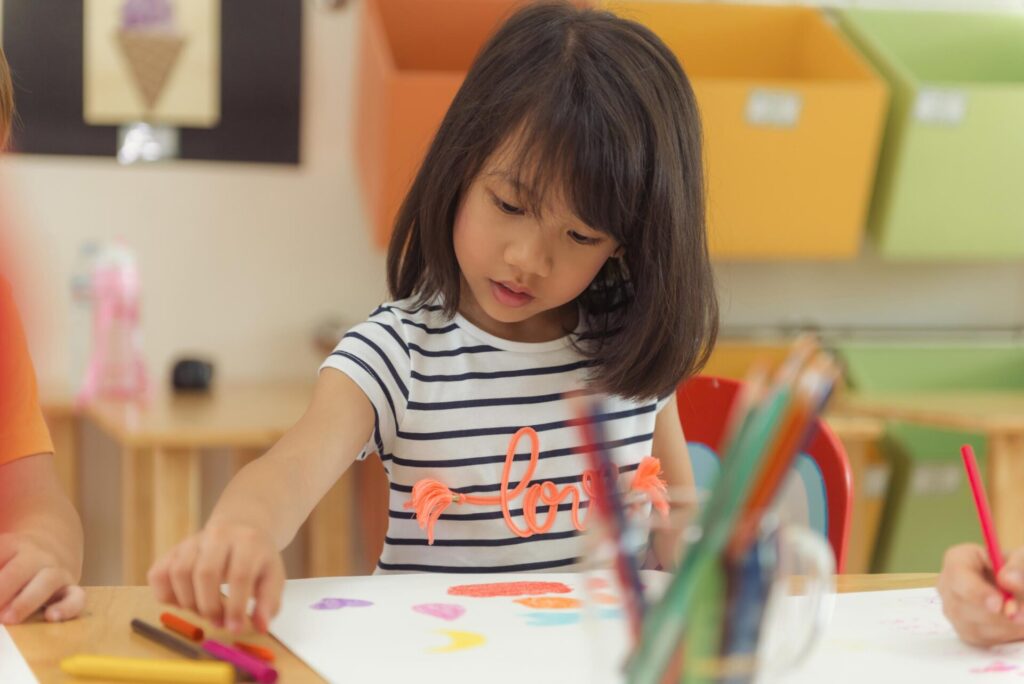
(2) Focus on Infrastructure 1960-90
After 1945, in the other poorer countries of Asia and Africa, the newly created World Bank and bilateral contributions from the former colonial powers only became active in the 1960s. The proportion of aid devoted to education was initially modest – 8% in that first decade rising to 11% in the 1970s but less again in the 1980s. The emphasis of education aid at the outset was on infrastructure and vocational workforce development. Two-thirds of World Bank educational lending during the 1970s was directed to the construction of schools and around 30% was used to purchase equipment (Tilak,1988). OECD aid statistics suggest nearly 50% of bilateral aid went to secondary and nearly one-third to tertiary and technical education. Much of this aid was tied and not targeted to the local needs but rather to the donor’s political objectives. Little thought was given to the educational outcomes being sought. Not surprisingly, among low-income African countries, only Botswana had a miracle like South Korea’s. And that was due not to aid, but to its far-sighted and benevolent President investing consistently more than 20% of Government revenues, boosted by the 1972 discovery of diamonds, into education.
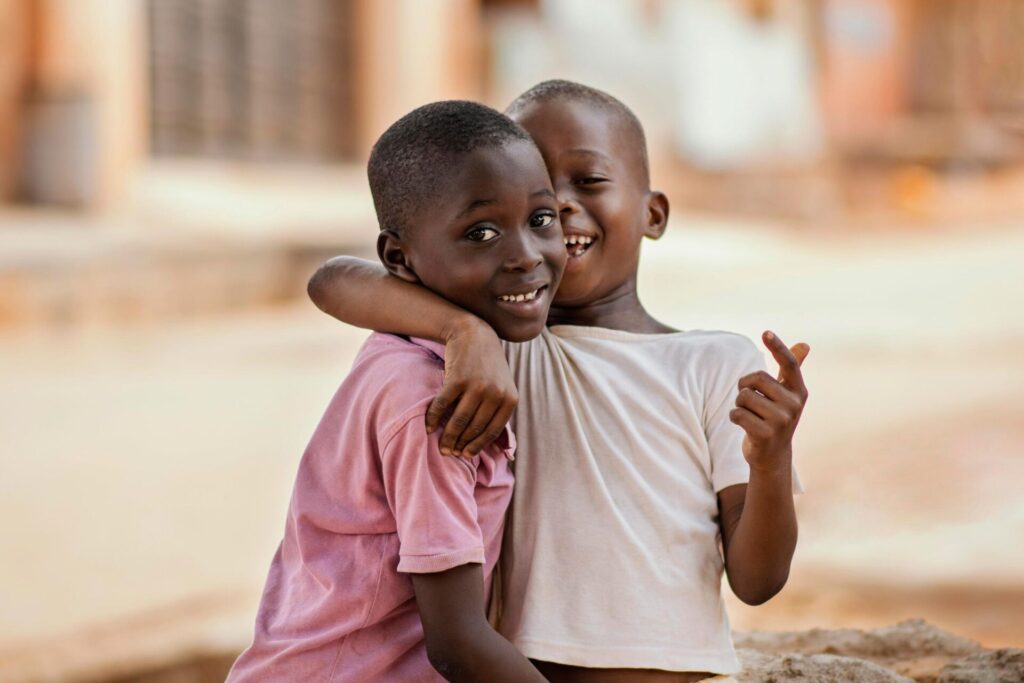
(3) A Shift towards Primary Education in the 1990s
The United Nations General Assembly had in one of its first resolutions in 1948 highlighted the right of everyone to have free access to elementary education (Article 26 of the Universal Declaration of Human Rights). Yet it was only more than 40 years later that the 1990 Declaration of Education for All adopted by UNESCO and other multilaterals signalled a significant shift in education aid priorities to primary education. “Every person – child, youth and adult – shall be able to benefit from educational opportunities designed to meet their basic learning needs.” (Article 1 of the 1990 Declaration). This rallying cry recognised that one billion of the world’s adults were illiterate with hundreds of millions of children destined for the same fate through no access to basic education. Such a fundamental shift in aid priorities was also justified by emerging analytical models that assessed educational outcomes and calculated the economic rates of return on education investment. These studies typically found that primary education exhibited the highest economic returns, with average rates of returns to an additional year of schooling in the order of 10%, particularly among developing countries.
(4) Lifelong Learning
In 1996, Jacques Delors’ International Commission on Education for the 21st Century further enhanced the debate by urging the world to move towards a necessary Utopia in which none of the talents hidden like buried treasure within every person be left untapped. The need for lifelong learning built on the four pillars of learning to know, to do, to be and to live together should guide educational policy choices, the training of teachers, the incorporation of technology, and facilitate flexible learning paths. More international funding and co-operation (with UNESCO proposed as the key player) would clearly be needed to support this vision.
(5) The Millennium Development Goals
After marking time in the 1990s, the quantum of aid to education did increase in the new century, especially after the Millennium Development Goals included an ambition for universal primary education by 2015. However, this graphic indicates that other MDGs in support of health and government and civil society institutions became a more important focus for official development assistance. Perhaps this was because the thinking as to how improved educational outcomes could be measurably achieved by aid funding had still not been done.
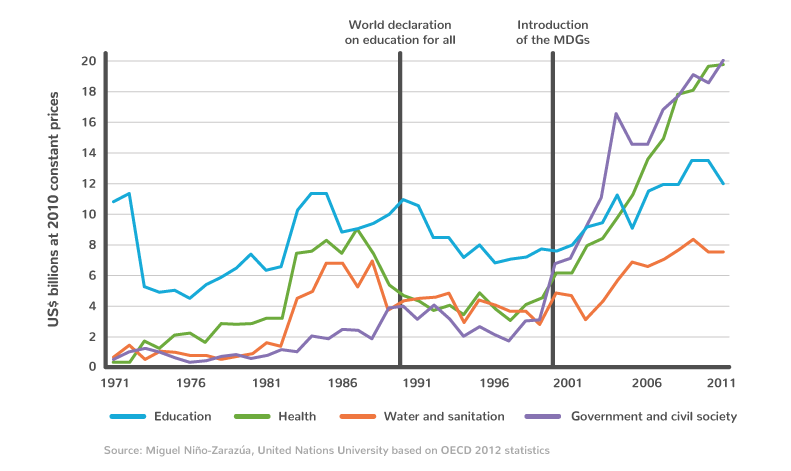
Nevertheless, a growing proportion of education aid has in the last 25 years flowed to the primary sector and with some positive results. The World Bank’s Facing Forward study of Schooling for Learning in Africa reported that enrollments in Sub-Saharan African primary education surged from 63 million students in 1990 to 152 million students in 2013. Net enrollment rates in primary school have risen sharply, from a regional average of 54 percent in 1999 to 78 percent in 2013. Other gains include drastic reductions in the numbers of children out of school (although the out of school % has since 2015 stopped falling) and much improved gender parity with the number of countries with fewer than 90 girls enrolled in primary school for every 100 boys halving.
(6) SDG 4 – Recognition of the Need for Detailed Targets
Since the adoption in 2015 by the UN General Assembly of the 2030 Agenda for Sustainable Development, and of SDG 4 in particular, a major step forward has been the recognition that long term goals of this kind require multiple precise and detailed targets, both quantitative and qualitative, and a mechanism for monitoring and reporting of progress towards the goal. Hence the ten SDG 4 targets, including relevant and effective learning outcomes and a Framework for Action under which UNESCO tracks a series of global indicators of progress towards the targets.
(7) Are Students Learning?
Now at least we are discovering that although the issue of access to schooling is closer to solution, such data as we have about learning levels, particularly in Sub-Saharan Africa, suggests that a large proportion of the students learn very little while at school. Being at school does not mean students are learning or, if they are learning, their pace is too slow – the 2015 baseline rate of progress in maths at our Kenyan iMlango project was 0.58 of a curriculum year for each year at school. So, falling behind so much in every year of primary school, it should not be a surprise that four in 10 primary school graduates apparently lack basic proficiency in reading and math according to the Global Partnership for Education. And many millions still do not graduate at all, let alone progress to secondary school. UNESCO’s latest forecast is that in 2030 only 68% of children in low income countries will complete primary school within 3-5 years of the intended age of the last grade while only 44% and 21% of adolescents in those countries will complete lower and upper secondary on the same basis. The SDG 4 school completion goals on that basis will be missed by a mile! UNESCO are still seeking to refine their learning indicators but the World Bank’s 2018 Development Report stated that in Sub-Saharan Africa, less than 7 percent of students in late primary school are proficient in reading, and only 14 percent in mathematics. Worldwide, the learning crisis is such that 600 million children or close to 60% of all children and adolescents can neither read nor do basic maths, and if anything, UNESCO are concerned that learning levels in Sub-Saharan Africa will, far from approaching the SDG 4 target, deteriorate further from today’s position.
(8) Funding Stops Growing
Continued poor learning outcomes and, in some countries, the simple lack of data surely in part explain the difficulty in mobilising higher levels of funding for education. Official development funding actually flatlined between 2010 and 2015 (a delayed reaction to the global financial crisis perhaps) before rising in 2016 (see the chart below). Meanwhile, although private development assistance has been growing much faster than government aid (PDA is now equivalent to at least 25% of ODA),corporate giving to education is insufficiently prioritized, with, for example, Fortune 500 companies spending only 3 percent of their total global CSR on education in developing countries – a clear indication that such donors are lacking an adequate understanding of the outcomes they could expect (Source: Liesbet Steer, Brookings Institution).
Aid to education reached a high in 2016
Total aid to education disbursements, by level of education, 2002-2016
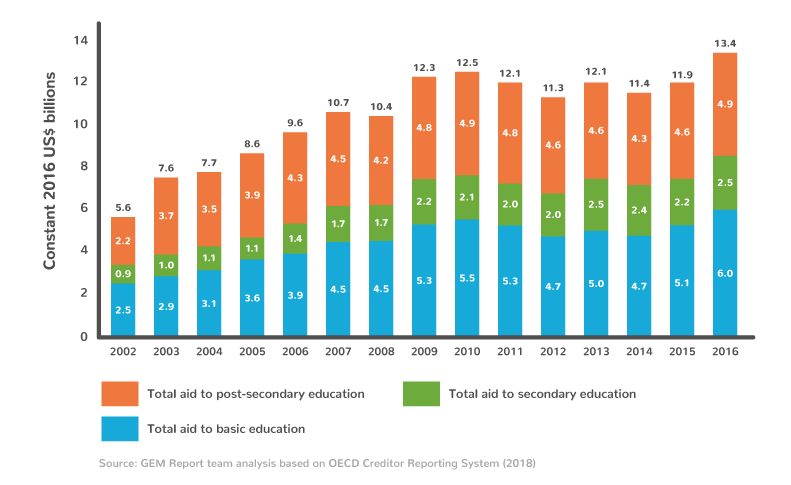
(9) The Size of the Challenge
UNESCO put these numbers into context with their estimate that annual spending on education worldwide is US$4.7 trillion of which US$3 trillion (65% of the total) is spent in high-income countries and only US$22 billion (0.5% of the total) in low-income countries, even though the two groups have roughly equal school-age populations. Donors account for 12% of total education expenditure in low-income countries (US$ 2.5 billion) and 2% in lower-middle-income countries (say, US$10 billion). The Global Education Monitor Report’s estimate of an annual funding gap of at least US$39 billion per year between 2015 and 2030 in low- and lower-middle-income countries seems a rather modest assessment of what might be needed in money terms to approach the SDG 4 goal. Nevertheless, to make up that shortfall, aid to education would need to increase sixfold from its 2010 levels, say GEM.
Given the existing concentration in funding by the identity of the official donors shown below, it seems unlikely that such increases in official aid are feasible.
The United States, the United Kingdom and the World Bank account for almost half of total aid to basic education
Top 10 bilateral and multilateral donors to basic education, 2004-2006, 2009-2011, 2014-2016
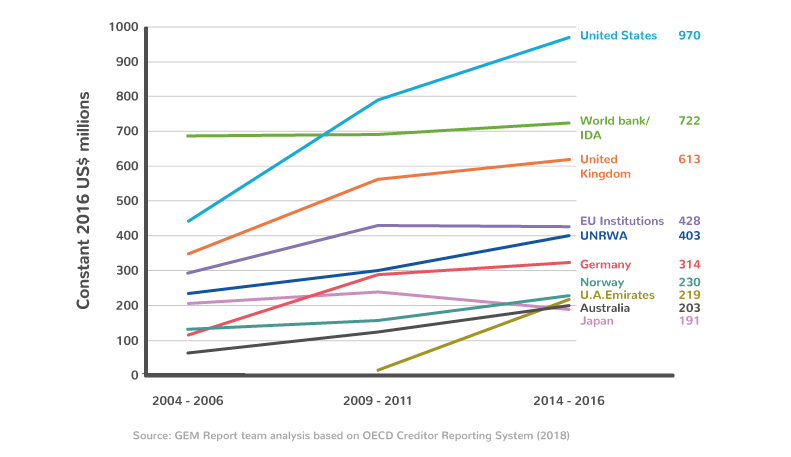
(10) Is the Money Going to the Right Places?
Big questions in any event surround the apparent lack of coordination in where aid funding is directed. Liesbet Steer of the Brookings Institution reviewed disbursements for basic education across 30 countries between 2011 and 2013 and calculated that the average disbursement of ODA per child in constant 2012 dollars ranged from $58 in Liberia to $20 in Kenya and Tanzania down to just $4 in Chad, huge variances by any standard.
A further negative, as UNESCO has commented, is that humanitarian aid systems seem to neglect the education of children and adolescents in countries affected by or emerging from conflict, and with a growing proportion of the world’s out of school students living in such countries, more and better targeted aid for them is needed.
Finally, funders seem more inclined to seek out new projects than to provide follow-on funding to projects which have demonstrated promise. Addressing the challenges of achieving learning outcomes at scale takes a long time and will usually require several course corrections. The timeframe is likely to outlast the initial funding. When students in the DFID backed iMlango Project first had access to Maths-Whizz for 30-89 minutes per week, they only progressed by 0.68 of a curriculum year – modestly above the baseline referred to above. Between January and June 2019, those students are achieving an average rate of progress of approximately 1.3 years for each year of study, more than double the baseline. Work on scaling out the conditions that facilitate this level of progress remains and that is where follow up funding, to take over from DFID in 2021, would be able to leverage the investment already made and fully realise the learning outcome potential that has been built up. Private sector funders especially – we would love to hear from you.
What We Still Don’t Know To Achieve SDG 4
So there appears to be a need for vastly increased funding to be devoted to the attempt to achieve SDG 4. However, is it any surprise that donors are doubtful when it appears we still do not know why results in schools are so poor and what might work in the countries with such poor performing education systems to improve them?
Could one of the issues be that although enrolled in school, many students just do not attend regularly? If so, how could we change this – Esther Duflo’s analysis in “Poor Economics” is interesting in showing the extra years of schooling which come from spending $100 on different solutions to the problem: surprisingly only 1 or 2 extra years from spending the money on additional teachers and scholarships but 28 extra years from deworming the children and 40 extra years from providing information on the returns from education to the parents. Is one of the main reasons that little is learned in African primary schools that the language of instruction is typically not the mother tongue but one of the colonial languages – Save The Children argued passionately for mother tongue based education in their detailed 2009 report and UNESCO repeated the arguments in 2016. Even if the key to improved educational outcomes was agreed to be effective teaching in the mother tongue, what chance is there of training up the 69 million teachers which the UN has estimated would be required to achieve universal primary and secondary education by 2030 and how best would this be achieved?
Quite apart from the language of instruction, do we actually know what these teachers should be teaching? Do we know how to teach and assess 21st century skills like problem solving, collaboration, critical thinking, and communication? Are Western models of education whether a 20th or 21st century version of maths, science, language, and social studies a relevant curriculum for students in impoverished countries who appear first to need knowledge and skills in health and hygiene, financial literacy, small business development, community problem solving etc ahead of academic studies?
Misdirected funding for nebulous goals before this myriad of vital issues have been thought through and applied in each local context is likely to lead to continuing disappointment.
Towards More and Better Data
The World Bank’s 2018 Report: Learning to Realize Education’s Promise emphasises the importance of gathering timely and accurate data to guide educational development policy. Estimates suggest that only three percent of official development assistance for education is spent on global public goods such as data and research; for health, that share is 20 percent. Returns from investing more on education data could be enormous if they help focus attention on ensuring that students attain basic skills in their early years, and if they permit proper assessment of what interventions produce the best returns like the analyses by Esther Duflo and others referred to above.
UNESCO have repeated the World Bank’s call. It admits that the methodologies and measurement tools for several of the SDG 4 indicators are still under development. “Data availability – in terms of both country coverage and time series – is a major constraint. The lack of effective international cooperation is a key factor that has held back progress. Fewer than half of countries report data on flagship indicators, such as learning outcomes in primary and secondary education. For other indicators, such as public expenditure, the information is available only with a considerable time lag. For yet other indicators, such as trained teachers, comparability is weak.”
In 2018, the World Bank launched its Human Capital Index which is designed to capture the amount of human capital a child born today could expect to attain by age 18. A key component of the HCI is information on the quantity of education a child can expect to obtain by age 18 combined with a measure of its quality, the latter necessarily involving an assessment test. “A global learning metric” says the World Bank “could help bring learning centre stage, making it more salient. Such a metric would use an internationally comparable scale to consistently track progress and identify gaps across contexts. It would enable comparisons across children, households, schools, and locations. Beyond its technical dividends, a global metric would motivate action and generate accountability for learning. By showing what is possible, it could point to what countries should be aspiring to—and create pressure to meet those aspirations…Furthermore, comparable learning data could increase the effectiveness of global research, international partnerships, and global aid for learning. Such data could also help countries develop their capacity for analyzing results to drive policy.”
The argument for international investment in reliable educational data gathering seems incontrovertible. The issue is how to achieve the objective. In reality, good education programme design incorporates real time data gathering as an essential built-in feature of the design not as an afterthought. Platforms such as Maths-Whizz, which enable teachers and administrators to gather educational assessment data at the same time as children are being taught, must offer promise if they can be implemented on the ground in a cost effective way. Our metric, Maths Age™, which measures a child’s maths knowledge as the level we would expect of a typical student of the same age, is already in use as an international basis of comparison. Such tools and metrics might also lend themselves to a payment by results formula and/or funding by means of social impact bonds, both now highly sought after and novel methods of expanding the flow of funds to international educational development.
Conclusion: Lessons can be learned
Realistically, achieving the SDG 4 targets at a global level represents an imposing challenge, but is it out of reach? The early example of South Korea in the 1945-1960 period showed that with the right combination of funding and intelligent investment in educational resources, high quality universal primary education is achievable within a 12-15 year time frame. Current challenges surround the fact that international aid efforts in education have not experienced a similar level of success in the last 60 years which has had a negative knock-on effect on education funding that’s clearly lacking.
Undoubtedly the use of technology can positively influence the likely achievement of SDG 4, albeit reliant on improved provision and interpretation of data on learning outcomes, and on the factors leading to learning outcomes. This in turn could influence donors, both governmental and private sector and provide the much-needed funding that has been lacking. The scope for higher productivity from international funding of data-driven education initiatives is huge, and this would in turn expand the funding available. Meanwhile, basic issues concerning curriculum and language of instruction need common sense examination country by country. Technology should have an increasing role to play, both in delivering effective and relevant education at a low marginal cost and in supplying the data to justify its use in real time, and as a by-product of delivering good educational outcomes. Taking all the issues into account, SDG 4 remains the goal we all as Educators strive to achieve in spite of the challenges.
Links to Key Sources
Foreign Aid for education (J.G.Tilak) – https://doi.org/10.1080/17516230701835898
Universal Declaration of Human Rights – https://www.un.org/en/universal-declaration-human-rights/
World Declaration on Education for All – https://unesdoc.unesco.org/ark:/48223/pf0000127583
Learning: The Treasure Within (Jacques Delors) – http://www.unesco.org/education/pdf/15_62.pdf
Sustainable Development Goal 4 – https://sustainabledevelopment.un.org/sdg4
Human Capital Project – https://www.worldbank.org/en/publication/human-capital
